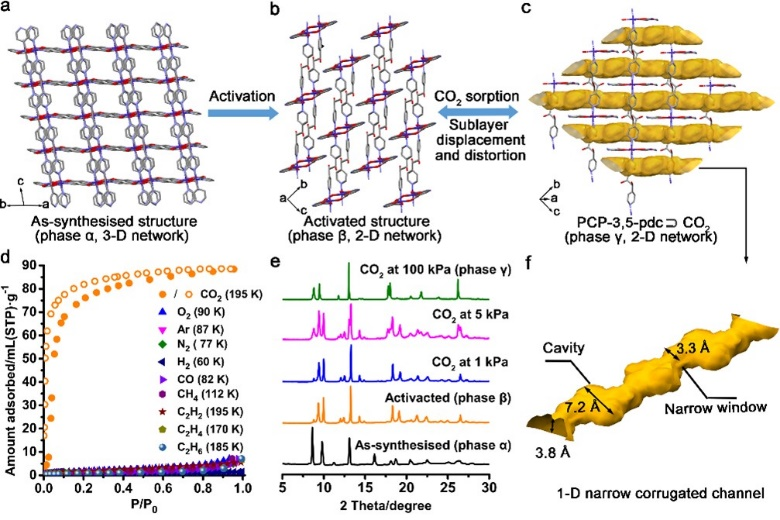In July 2023, progress in ultra-precise CO2 molecular recognition and green efficient gas separation materials was made by Professor Li Fengting’s team of our institute, in collaboration with Academician of the Japan Academy, Professor Susumu Kitagawa’s team of Kyoto University. The research was supported by the National Key R&D Program of China under the Government International Cooperation Key Project. The ultra-precise molecular recognition and highly efficient separation of CO2 was realized through precisely designing the pore environment of flexible porous materials and optimally integrating multiple molecular recognition mechanisms. The research entitled “Soft corrugated channel with synergistic exclusive discrimination gating for CO2 recognition in gas mixture” was published in Nature Communications (DOI: 10.1038/s41467-023-39470-w), the prestigious international journal in chemistry.

PCP Material with Ultra-Precise CO2 Molecular Recognition Performance
CO2 is an essential greenhouse gas and a significant impurity in the mixture of various industrial gases. The development of technologies related to CO2 molecular recognition, separation, capture, and resource utilization is vital for national economy and sustainable development, aligning with China’s major strategy of carbon peaking and carbon neutrality goals. The research realized ultra-precise CO2 molecular recognition by precisely designing and regulating the flexibility, pore morphology, and active sites of PCP material. The material exhibits exclusive discrimination gating (EDG) effect for selective gate-opening adsorption of CO2 over nine similar gas molecules, including CO2, N2, CH4, CO, O2, H2, Ar, C2H2, C2H4, and C2H6, and outstanding CO2 capture performance in mixed gases. Single-crystal XRD, in-situ synchrotron PXRD, and theoretical calculations indicate that the feasible design of narrow-corrugated channels, active sites, and appropriate flexibility in PCP are the key to achieving ultra-precise CO2 molecular recognition. The School of Environmental Science and Engineering in Tongji University is the first institution of this paper, with Professor Li Fengting, Professor Ken-ichi Otake, and Professor Susumu Kitagawa as the corresponding authors. Research Fellow Gu Yifan from Tongji University is the first author, and Professor Wang Ying is a co-author.
Over the same period, Research Fellow Gu Yifan and Associate Professor Wu Yinan from the team published several papers on CO2 adsorption and catalytic conversion, green efficient gas separation, and water capture technology in journals such as Green Chemistry, Coordination Chemistry Reviews, and Small, along with multiple authorized patents obtained.